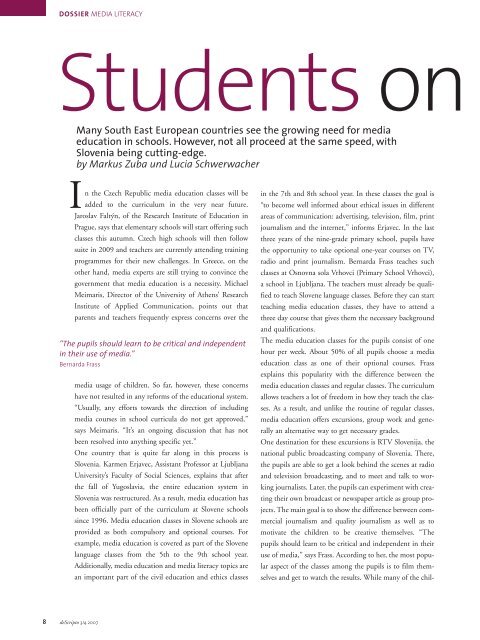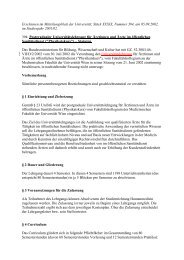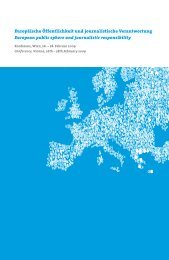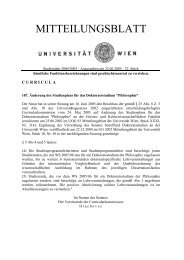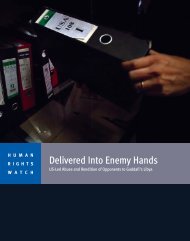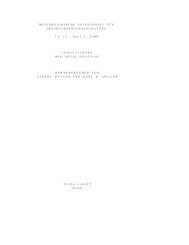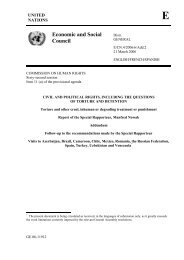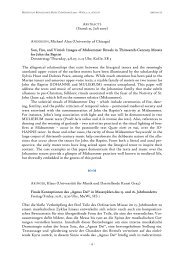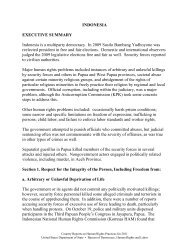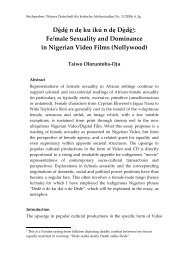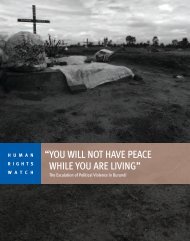DOSSIER
DOSSIER
DOSSIER
Create successful ePaper yourself
Turn your PDF publications into a flip-book with our unique Google optimized e-Paper software.
<strong>DOSSIER</strong> MEDIA LITERACY<br />
Students on<br />
Many South East European countries see the growing need for media<br />
education in schools. However, not all proceed at the same speed, with<br />
Slovenia being cutting-edge.<br />
by Markus Zuba und Lucia Schwerwacher<br />
In the Czech Republic media education classes will be<br />
added to the curriculum in the very near future.<br />
Jaroslav Faltýn, of the Research Institute of Education in<br />
Prague, says that elementary schools will start offering such<br />
classes this autumn. Czech high schools will then follow<br />
suite in 2009 and teachers are currently attending training<br />
programmes for their new challenges. In Greece, on the<br />
other hand, media experts are still trying to convince the<br />
government that media education is a necessity. Michael<br />
Meimaris, Director of the University of Athens’ Research<br />
Institute of Applied Communication, points out that<br />
parents and teachers frequently express concerns over the<br />
“The pupils should learn to be critical and independent<br />
in their use of media.”<br />
Bernarda Frass<br />
8 deScripto 3/4 2007<br />
media usage of children. So far, however, these concerns<br />
have not resulted in any reforms of the educational system.<br />
“Usually, any efforts towards the direction of including<br />
media courses in school curricula do not get approved,”<br />
says Meimaris. “It’s an ongoing discussion that has not<br />
been resolved into anything specific yet.”<br />
One country that is quite far along in this process is<br />
Slovenia. Karmen Erjavec, Assistant Professor at Ljubljana<br />
University’s Faculty of Social Sciences, explains that after<br />
the fall of Yugoslavia, the entire education system in<br />
Slovenia was restructured. As a result, media education has<br />
been officially part of the curriculum at Slovene schools<br />
since 1996. Media education classes in Slovene schools are<br />
provided as both compulsory and optional courses. For<br />
example, media education is covered as part of the Slovene<br />
language classes from the 5th to the 9th school year.<br />
Additionally, media education and media literacy topics are<br />
an important part of the civil education and ethics classes<br />
in the 7th and 8th school year. In these classes the goal is<br />
“to become well informed about ethical issues in different<br />
areas of communication: advertising, television, film, print<br />
journalism and the internet,” informs Erjavec. In the last<br />
three years of the nine-grade primary school, pupils have<br />
the opportunity to take optional one-year courses on TV,<br />
radio and print journalism. Bernarda Frass teaches such<br />
classes at Osnovna sola Vrhovci (Primary School Vrhovci),<br />
a school in Ljubljana. The teachers must already be qualified<br />
to teach Slovene language classes. Before they can start<br />
teaching media education classes, they have to attend a<br />
three day course that gives them the necessary background<br />
and qualifications.<br />
The media education classes for the pupils consist of one<br />
hour per week. About 50% of all pupils choose a media<br />
education class as one of their optional courses. Frass<br />
explains this popularity with the difference between the<br />
media education classes and regular classes. The curriculum<br />
allows teachers a lot of freedom in how they teach the classes.<br />
As a result, and unlike the routine of regular classes,<br />
media education offers excursions, group work and generally<br />
an alternative way to get necessary grades.<br />
One destination for these excursions is RTV Slovenija, the<br />
national public broadcasting company of Slovenia. There,<br />
the pupils are able to get a look behind the scenes at radio<br />
and television broadcasting, and to meet and talk to working<br />
journalists. Later, the pupils can experiment with creating<br />
their own broadcast or newspaper article as group projects.<br />
The main goal is to show the difference between commercial<br />
journalism and quality journalism as well as to<br />
motivate the children to be creative themselves. “The<br />
pupils should learn to be critical and independent in their<br />
use of media,” says Frass. According to her, the most popular<br />
aspect of the classes among the pupils is to film themselves<br />
and get to watch the results. While many of the chil-


